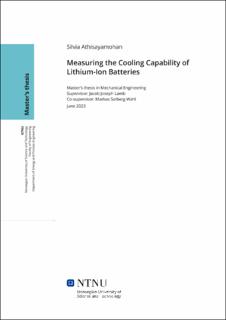| dc.contributor.advisor | Lamb, Jacob Joseph | |
| dc.contributor.advisor | Wahl, Markus Solberg | |
| dc.contributor.author | Athisayamohan, Silvia | |
| dc.date.accessioned | 2023-09-14T17:20:10Z | |
| dc.date.available | 2023-09-14T17:20:10Z | |
| dc.date.issued | 2023 | |
| dc.identifier | no.ntnu:inspera:142433533:26512035 | |
| dc.identifier.uri | https://hdl.handle.net/11250/3089597 | |
| dc.description.abstract | Denne oppgaven har som formål å evaluere kjøleevnen til litium-ionbatterier. Temperatur har vist seg å ha en betydelig innvirkning på levetiden til batteriene. Et hensiktmessig kjølesystem og en optimalisert utforming av det termiske styringssystemet er avgjørende for å sikre en trygg driftstemperatur under sykluser. Dette forhindrer overoppheting og reduserer risikoen for brann og eksplosjon.
Oppgaven undersøker kjøleevnen til litium-ionbatterier ved å evaluere den termiske ledningsevnen til elektrodene, måle Cell Cooling Coefficient (CCC), og analysere Skanningelektronmikroskop (SEM) bilder. Videre gir målinger av termisk ledningsevne detaljert informasjon om varmetransporten i batteriet. Det ble observert betydelige variasjoner i den termiske ledningsevnen for tørre og våte elektroder under ulike komprimeringstrykk. Resultater fra CCC-metoden indikerer at økning av frekvensområdet 0.25Hz til 1Hz ikke påvirker CCC_Surface, som forblir omtrent 0.8W/K i begge tilfeller. SEM-bilder bekrefter at batteriet fungerte normalt under CCC-målingene og gir innsikt i de termiske egenskapene og elektrokjemiske reaksjonene som oppstår i batteriet.
Utfallet av denne oppgaven bidrar til økt forståelse av de termiske egenskapene og kravene til termisk styring av litium-ionbatterier. Dette gir et godt grunnlag for videre forskning og undersøkelser av kjølesystemer som kan imøtekomme den økende etterspørselen etter litium-ionbatterier. | |
| dc.description.abstract | This thesis aims to measure the cooling capability of Lithium-ion batteries (LiBs). The temperature has been shown to have a significant impact on the longevity of the batteries. A proper cooling system and an optimized design of the thermal management system (TMS) are essential to ensure that the operating temperature is within a safe range during cycling. This prevents overheating and reduces the risk of fire and explosion.
The study investigates the cooling potential of LiBs by examining different cooling setups at various frequencies and their impact on heat dissipation. This is explored by evaluating the thermal conductivity of the electrodes, analyzing Scanning Electron Microscope (SEM) images, and measuring the Cell Cooling Coefficient (CCC). Results from the CCC method indicate that an increase in the frequency range from 0.25Hz to 1Hz does not affect the CCC_Surface and remains approximately 0.8W/K for both cases. Furthermore, thermal conductivity measurements gave detailed information on heat transport in the battery. Noticeable variations were observed in the thermal conductivity for dry and wet electrodes under different compaction pressure. SEM images confirm that the battery functioned normally during the CCC measurements and gives an understanding of the thermal properties and electrochemical reactions that occurs in the battery.
The findings of this thesis contribute to the understanding of the thermal properties and thermal management requirements of LiBs. This is a foundation for further research and investigation in cooling systems, which are required to meet the increasing demand for LiBs. | |
| dc.language | eng | |
| dc.publisher | NTNU | |
| dc.title | Measuring the Cooling Capability of Lithium-Ion Batteries | |
| dc.type | Master thesis | |
